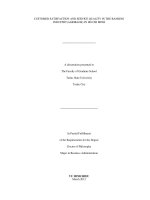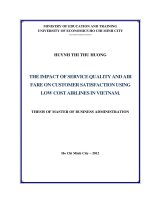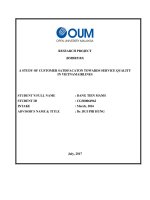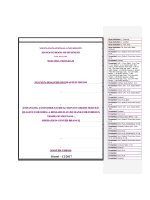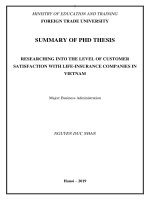Factors impacting customer satisfaction from banking service quality in vietnam
Bạn đang xem bản rút gọn của tài liệu. Xem và tải ngay bản đầy đủ của tài liệu tại đây (381.29 KB, 11 trang )
JOURNAL OF CRITICAL REVIEWS
ISSN- 2394-5125
VOL 8, ISSUE 01, 2021
Factors Impacting Customer Satisfaction from
Banking Service Quality in Vietnam
Nguyen Hoang Tien
Saigon International University, Vietnam
Dinh Ba Hung Anh
Ho Chi Minh City University of Technology, Vietnam
Phung The Vinh
Hoa Sen University, Vietnam
Tran Hong Son
Hutech University, Vietnam
Summary: This article based on the analysis of business activities of BIDV (Joint stock
Bank for Investment and Development of Vietnam), one of the Big4 Banks in Vietnam.
Through the research survey of selected groups of customers in Vung Tau province the
authors haveidentified impacting factors on their satisfactions from ATM service quality of
BIDV. The research aim of authors is to use quantitative analytical tools to determine the
level of impact of identified factors on customers’satisfaction from ATM services quality
of BIDV in Vung Tau province. As next, the next research aim of the authors is to propose
a set of adequate solutions to boost customers’ satisfaction related with ATM service
quality of BIDV in Vung Tau Province.
Key words: impact factors, solutions, customer satisfaction, commercial bank, BIDV.
I. INTRODUCTION
As a modern and multi-utility banking product, ATM card has become a popular
non-cash payment method in the world in general and in Vietnam in particular. It is
considered a self-service banking channel, an important tool in retail banking. Thanks to
the flexibility and utility brought to its owners, ATM card has been attracting the interest
of the whole community and increasingly asserting its position in the banking business.
Joint Stock Commercial Bank for Investment and Development of Vietnam (BIDV)
has focused on developing card service, improving service quality. Phu My Joint Stock
Commercial Bank for Investment and Development (BIDV Phu My), a branch of BIDVin
Vung Tau province is also under great competition in the card service with other banks
offering the same services such as Vietcombank, Vietinbank, Agribank, Asia Commercial
Bank, Sacombank and customers are the decisive factors for the existence of banks.
This article will help BIDV Phu My in understanding the factors affecting customer
satisfaction when using ATM cards, the level of influence of each factor, thereby
supporting BIDV Phu My managers in finding solutions to improve service quality
towards maximum satisfaction of card users, tapping to the potential of the card market,
enhancing market share and maximizing profits from this business.
II. THEORETICAL FRAMEWORK
2.1.Quality of Banking Services
According to the International Organization for ISO Standardization, in the ISO
9000: 2015 draft (quoted according to the Appropriate Certification Center QUACERTMinistry of Science and Technology), the quality definition is as follows: “Quality is the
ability to incorporate the characteristics of a product, system or process to meet the
requirements of customers and stakeholders”. According to Parasuraman & et al (1988),
1140
JOURNAL OF CRITICAL REVIEWS
ISSN- 2394-5125
VOL 8, ISSUE 01, 2021
service quality is the gap between the expectation of customers about the service and their
perception of the results when using the service. Cronin and Taylor (1992) believe that the
quality of service is the quality that customers feel without comparing with expectations
because it confuses customers and makes it difficult to distinguish. There are many
different statements about service quality but from a customer-oriented point of view,
service quality means meeting customer expectations, satisfying customer needs.
Therefore, the quality of service is determined by the customer, according to the
customer's wishes and requirements. The quality of services is of relative nature due to the
same level of service quality will be assessed differently by different customers and even
by the same customer but at different stages (Tien, 2020; Tien et al, 2020a; Tien et al,
2020b; Tien et al, 2020c).
The quality of banking services in general and the quality of ATM card services in
particular is the extent to which the ATM/banking card service meets the needs and
expectations of customers, or in other words, that all the additional activities and benefits
that bank services/ATM card services bring to customers to establish, strengthen trust, and
expand long-term partnerships with customers through creating the satisfaction for
customers when using the service (Circular 19/2016/NHNN). In general, the quality of
banking services is an evaluation and a general feeling of customers about all products and
services provided by the bank, it depends on the quality of each product and service,
including ATM card service. The quality of ATM card services that are assessed as good
will contribute to improve the service quality of the bank. Like service quality in general,
banking services in particular, the quality of ATM card services is closely related to the
needs of customers. Quality is the satisfaction of customers' needs, if a product or utility of
an ATM card service does not meet the needs of customers, it is considered to be of poor
quality. In today's competitive business environment where service providers must always
target customers' needs and try their best to meet those needs, this feature becomes even
more important than ever. Because the quality is measured by the level of demand
satisfaction, the demand is always fluctuating, so the quality also fluctuates with time,
space and conditions of use. Quality of service to satisfy customer needs can be clearly
stated in the form of regulations and standards, but sometimes in reality the quality of
products and customer services can only be felt in and after the end of the use process
(Tien et al, 2019a; Tien et al, 2019b; Tien et al, 2019c).
2.2.
Customers’ Satisfaction
According to Parasuraman et al (1988), customer satisfaction is a reaction to the
perceived difference between known experience and customer expectations of service.
According to Kotler and Keller (2006), according to Le, Nguyen, Do, Le and Tang (2014),
customer satisfaction is the level of emotional state stemming from a comparison between
product perceptions and customer expectations when using the service. More specifically,
according to Oliver (1997), customer satisfaction is an emotional response, the overall
feeling of the customer to the service provider on the basis of comparing the difference
between what they get and what they expected earlier.
Thus, each concept has different expressions but collectively, customer satisfaction
is understood as customer evaluation of a product or service that meets their expected
needs or not. Customer satisfaction depends on the efficiency or benefits of products and
services compared to what they are expecting. Customers can have different levels of
satisfaction. If the efficiency of products and services is lower than expected, customers
will feel dissatisfied. If the efficiency of the product or service matches the expectations,
customers will feel satisfied. If the efficiency of products and services is higher than
expected, customers will be very satisfied and feel happy. It can be said that customer
satisfaction is associated with customer expectations. Expectations are based on the
1141
JOURNAL OF CRITICAL REVIEWS
ISSN- 2394-5125
VOL 8, ISSUE 01, 2021
previous experience of customers, friends’ opinions and marketers’ information. Therefore,
in order to satisfy customers, the bank must understand the expectations of customers and
thereby give reasonable expectations. If low expectations are given, bank can satisfy
customers but it is not enough to attract customers. On the contrary, if expectations are
raised too high, customers may be disappointed (Tien & Ngoc, 2019; Tien & Anh, 2017;
Tien, 2019).
2.3.Research Model
The proposed research model is based on the SERVQUAL model of Parasuraman,
including 5 independent variables to measure the quality of ATM card services at the
BIDV Phu My. These variables are presented below (Figure 1):
Figure 1.Research model
Reliability
Responsiven
ess
Customer
satisfaction
Service
capacity
Tangibility
Empathy
Source: Authors’ development
- Reliability (DTC): reflected in the ability to provide the right service at the right
time and place; the fact that banks accurately record the data also shows the bank's
credibility; diverse utilities, high security features.
- Responsiveness (KNDU): demonstrating the willingness to serve and meet the
requirements of individual customers, speed of providing services to customers; the
willingness to pay attention and help customers; The correct communication to customers
when the service will be done also reflects the bank's responsiveness.
- Service capacity (NLPV): expressed through the bank's reputation in service
capability, transaction safety, professional qualifications of staff, polite and courteous
attitude of employees when delivering services.
- Empathy (SDC): expressed in the bank's policy programs showing interest in
individual customers using ATM card services;special attention of bank staff when dealing
with individual customers to during transaction; transaction time, branch network, ATM
network also show the sympathy of the bank with individual customers.
- Tangibility (SHH): expressed by spacious infrastructure and premises of the
bank's headquarters and transaction points; network of transaction points and ATMs is
wide and conveniently located, easy to identify, information systems and technical
equipment that banks use to provide modern ATM card services. Tangibility is also shown
through the appearance, costume or uniform of the staff when receiving and serving
customers. Banners, notice boards, brochures and accompanying materials while providing
services to customers trading at the bank.
1142
JOURNAL OF CRITICAL REVIEWS
ISSN- 2394-5125
VOL 8, ISSUE 01, 2021
In the banking industry, service quality is considered as a source of customer
satisfaction. Through a number of studies, it has been shown that service quality and
customer satisfaction have a positive relationship. On that basis, the author made the
following hypotheses:
H 1. When the level of reliability assessed by customers is rising, the level of
customer satisfaction will increase.
H 2. When the level of responsiveness assessed by customers is rising, customer
satisfaction will increase.
H 3. When the service capacity assessed by customers is rising, the customers
satisfaction will increase.
H 4. When empathy appreciated by customers is rising, the level of customer
satisfaction will increase.
H 5. When tangibility appreciated by customers is rising, the level of customer
satisfaction will increase.
III. RESEARCH RESULTS
3.1.Sample Information
From the theoretical model SERVQUAL of Parasuraman, the authors set up a draft
scale. From the draft scale, the author discusses a group of 10 customers and bank
employees to form a preliminary scale. After removing 3 observed variables, 22 observed
variables remain in preliminary scale. The survey was conducted with selected sample of
220 (number of questionnaires issued). The number of collected and valid questionnaires is
200. Samples are taken in a convenient way.
3.2.Analyzing the Reliability of the Scale with Cronbach’s Alpha Coefficient
- Scale measuring quality of service:
+ Scale of reliability:
Cronbach's Alpha of the scale is 0.894> 0.6, the correlation coefficients of the
observed variables in the scale are from 0.675 to 0.749> 0.3 and there is no case to remove
any observed variables that make Cronbach's Alpha of the scale greater than 0.894.
Therefore, all observed variables in this scale are accepted and used in subsequent factor
analysis.
+ Scale of responsiveness:
Cronbach's Alpha of the scale is 0.872> 0.6, the correlation coefficients of the
observed variables in the scale are from 0.648 to 0.791> 0.3 and there is no case to remove
any observed variables that make Cronbach's Alpha of the scale greater than 0.872.
Therefore, all observed variables in this scale are accepted and used in subsequent factor
analysis.
+ Scale of service capacity:
Cronbach's Alpha of the scale is 0.846> 0.6, the correlation coefficients of the
observed variables in the scale range from 0.608 to 0.772> 0.3 and there is no case to
remove any observed variables that make Cronbach's Alpha of scale greater than 0.846.
Therefore, all observed variables in this scale are accepted and used in subsequent factor
analysis.
+ Scale of empathy:
Cronbach’s Alpha of the scale is 0.530 <0.6, since there are two observed variables
SDC3 and SDC4 with a correlation coefficient of <0.3, so these two variables are
excluded. After removing 02 observed variables SDC3 and SDC4, and re-running the
whole process, Cronbach's Alpha rose from 0.530 to 0.822, the remaining variables in the
scale have the total variable correlation coefficient> 0.3 so they are both accepted and used
in subsequent factor analysis.
1143
JOURNAL OF CRITICAL REVIEWS
ISSN- 2394-5125
VOL 8, ISSUE 01, 2021
+ Scale of tangibility:
The tangible component with observed variables SHH5 <0.3 should be disqualified.
After removing the SHH5 variable, re-running the whole process, Cronbach's Alpha rose
from 0.765 to 0.887, the remaining variables in the scale have the total variable correlation
coefficients of 0.689 - 0.813> 0.3 so they should be accepted and used in subsequent factor
analysis.
- Scale measuring customers’ satisfaction:
The satisfaction scale with Cronbach Alpha relatively high at 0.823> 0.6, the
observed variables in this component have a relatively large correlation coefficient of> 0.3.
Therefore, the variables that measure this component are used in the subsequent factor
analysis.
3.3.Exploratory Factors Analysis
After Cronbach Alpha analysis and removal of three SDC3, SDC4 and SHH5
variables, the reliability coefficients of the variable groups were quite high and even>0.6;
the total variable correlation coefficients are >0.3. Therefore, the remaining 22 variables
are accepted and continue to be included in the factor analysis (Table 1).
Table 1.Observed variables used in the exploratory factor analysis (EFA) for independent
variables.
Factor
Code
Interpreration
DTC1
BIDV provides card services as committed
DTC2
BIDV actively addresses customers' obstacles
Card making procedure is simple, fast and convenient for
DTC3
customers
Reliability
DTC4
ATM system operates smoothly and accurately
DTC5
BIDV ATM card offers a variety of utilities
DTC6
BIDV keeps customers' information confidential
KNDU1 Staff tells customers when to perform the service
KNDU2 Staff are always ready to serve customers
Responsiveness
Fluent operator and quick implementation of customer
KNDU3
requests
KNDU4 Employees promptly resolve customer complaints
NLPV1 Behavior of employees to create trust for customers
NLPV2 Customers feel safe when using BIDV's ATM card service
Service
Staff are always polite, respectful and affable with
NLPV3
capacity
customers
Employees are knowledgeable enough to answer customer
NLPV4
questions
SDC1
BIDV has programs showing interest in customers
Empathy
SDC2
BIDV has reasonable and competitive card service fees
SDC5
Employees understand customers' needs
BIDV has modern equipment (computers, ATMs, cameras,
SHH1
...)
SHH2
Wide network of ATMs
Tangibility
Convenient ATM locations, easy-to-identify layout
SHH3
locations
SHH4
The interface of ATM is easy to use
SHH6
BIDV's card can be withdrawn at most other bank's ATMs
Source: Authors’ development
1144
JOURNAL OF CRITICAL REVIEWS
ISSN- 2394-5125
VOL 8, ISSUE 01, 2021
After running the factor analysis of independent variables, we get the following
results:
+ KMO and Barlett’s test results
Table 2. KMO and Barlett’s test
KMO and Barlett’s test
KMO indicator
0.83
Barlett’s test
2480.634
Df
231
Sig.
0
Source: Author’s investigation
The factor analysis results presented in Table 2 show that KMO index is 0.830>
0.5, which proves that the data used for factor analysis is completely appropriate. Barlett’s
test results are 2480,634 with the significance level (p_value) sig = 0.000 <0.05, meaning
that the variables are correlated with each other and satisfy the condition for factor
analysis.
+ Principal components analysis with Varimax rotation:
The results show that the original 22 observed variables are grouped into 5
groups.Total variance value = 70.344%> 50%: satisfactory; then it can be said that these
five factors explain 70.344% variation of data.The Eigenvalues coefficient values of the
factors are both high and greater than 1, the fifth factor has the lowest Eigenvalues =
1.360> 1.
+ Factors’ matrix with Principal Varimax rotation:
DTC1
DTC6
DTC5
DTC3
DTC2
DTC4
SHH6
SHH1
SHH2
SHH3
SHH4
KNDU2
KNDU3
KNDU4
KNDU1
NLPV1
NLPV4
NLPV3
NLPV2
Table 3. Factors matrix with Principal Varimax rotation
Component
1
2
3
4
5
0.825
0.793
0.783
0.783
0.78
0.761
0.877
0.818
0.799
0.79
0.764
0.896
0.838
0.808
0.776
0.878
0.851
0.789
0.725
1145
JOURNAL OF CRITICAL REVIEWS
ISSN- 2394-5125
SDC2
SDC5
SDC1
VOL 8, ISSUE 01, 2021
0.835
0.814
0.731
Source: Author’s investigation
There are 22 variables included in the factor analysis with 5 groups of factors being
created. The naming of factors is based on the observation of observed variables with a
large Factor loading within the same factor. Thus this factor can be explained by variables
with a large coefficient within it.
3.4.Correlation analysis and linear regression analysis
* Test of Pearson correlation coefficient:
Table 4. Correlation coefficients between dependent variables andindependent variables
Correlation
H
Statement
P
coefficient
When the level of trust is appreciated by
H1 customers, the level of customer satisfaction will
0.521
0
increase.
When the ability to meet customer appreciation
H2
0.462
0
increases, customer satisfaction will increase.
When the service capacity is assessed by
H3 customers, the satisfaction level of customers
0.458
0
will increase.
When empathy is appreciated by customers, the
H4
0.604
0
level of customer satisfaction will increase.
When tangibility is appreciated by customers, the
H5
0,419
0
level of customer satisfaction will increase.
Source: Authors’ investigation
On one hand, if the correlation coefficients between dependent variables and large
independent variables there is an evidence that they are interrelated and linear regression
analysis may be appropriate. On the other hand, if the independent variables also have a
big correlation with each other, then it is a sign that between them there may be a
multicollinear phenomenon in the linear regression model we are considering. The above
results show that the dependent variable has a relationship with all five independent
variables, in which the correlation coefficient between the satisfaction and the empathy of
the bank is the largest and correlation coefficient between the satisfaction and the
tangibility of the bank is the smallest.
* Linear regression analysis:
The linear regression method is performed with one-turn method, the regression
results are evaluated through the Adjusted R-square (used for model suitability assessment)
and the F test (model suitability test). At the same time, it is necessary to test the
multicollinearity phenomenon through considering the acceptability (tolerance) and
Variance Inflation Factors (VIF): if Tolerance is small and VIF> 10 these are signs of
multicollinearity. After conducting a linear regression analysis on the influence of factors
on customer satisfaction, we have the following results:
The coefficient R2 adjusted = 0.612 differing from 0 shows the research results of
model are valuable. The result of F test: F = 63.654 and Sig = 0.000. In addition, the
Tolerance of the observed variables is large and VIF of the variables with the largest value
1146
JOURNAL OF CRITICAL REVIEWS
ISSN- 2394-5125
VOL 8, ISSUE 01, 2021
is 1.426 <10. Therefore, the regression model is suitable for the data set and there is no
multicollinear phenomenon.
Mode
l
Const
DTC
KND
U
NLPV
SDC
SHH
Table 3. Regression results use the Enter method
Unstandardized
Standardized
Collinearity
Coefficients
Coefficients
Statistics
Beta
Variance
(Sig)
coStdanda
Beta
Toleran
Inflation
efficien rd Error
coefficient
ce
Factor(VI
t
F)
-0.797
0.244
-3.262 0.001
0.203
0.039
0.256 5.201
0
0.806
1.241
0.172
0.035
0.288
0.301
0.233
0.055
0.057
0.05
0.239
4.931
0
0.828
1.208
0.251 5.263
0
0.278 5.263
0
0.226 4.619
0
Source: Authors’ investigation
0.857
0.701
0.814
1.167
1.426
1.228
Thus, the linear regression equation looks like this:
Y = -0.797 + 0.278 x SDC (X4) + 0.256 x DTC (X1) + 0.251 x NLPV (X3) +
0.239 x KNDU (X2) +0.226 x SHH (X5)
Regression results show that all the independent variables: Reliability (X1),
Responsiveness (X2), Service capacity (X3), Empathy (X4), Tangibility (X5) have Sig.
<0.001, the variables are significant at the 99% reliability. Because at 99% reliability, the
independent variables affect the dependent variable which is the customer satisfaction.
Regression results show all 5 factors Empathy, Reliability, Service capacity,
Responsiveness, Tangibility have positive impact (+) on Customer satisfaction on quality
of ATM services of BIDV Phu My. This is entirely consistent with previous theories and
studies. The non-standardized beta coefficients in the non-standardized regression model
show that in the condition of maintaining the values of each other factor, the change of 1
unit value of one factor being considered will change 1 non-standardized beta value (of the
element being considered) on the dependent variable (Customer satisfaction) in the
following order:
(1) Empathy (Beta = 0.278)
(2) Reliability (Beta = 0.256)
(3) Service capacity (Beta = 0.251)
(4) Responsiveness (Beta = 0.239)
(5) Tangibility (Beta = 0.226)
IV. CONCLUSION
4.1.Conclusion
The results of measuring scale testing show that there are 5 components of service
quality including 22 variables that affect customer satisfaction, which are: (1) Reliability: 6
variables, (2) Responsiveness: 4 variables, (3) Service capacity: 4 variables, (4) Empathy:
3 variables, (5) Tangibility: 5 variables.
The "Empathy" component has the strongest impact on customer satisfaction
(Standardized Beta coefficient = 0.278). This shows that BIDV Phu My should pay much
attention to customers' interests, benefits and needs. In addition, the rates of bank card
1147
JOURNAL OF CRITICAL REVIEWS
ISSN- 2394-5125
VOL 8, ISSUE 01, 2021
service charges must be consistent with the benefits received and affordability of
customers. In fact, BIDV Phu My has recognized the importance of this factor and has
continuously tried to improve through the implementation of customer care policies. The
fee offered by BIDV Phu My must ensure the rationality and competitiveness compared to
the average level of other banks in the area.
The second strong impact on customer satisfaction is the "Reliability" component
with standardized Beta coefficient of 0.256. This proves that customer trust plays a very
important role for the bank's development. Customers only deal with banks when they feel
they can trust. BIDV Phu My must always pay attention to simplify procedures for issuing
and operating cards so that it is most convenient and quick as possible; actively addressing
customers' obstacles with 24-hour hotlines. Next thing to do is the continuous
improvement and upgrading of machinery and equipment systems to ensure that the ATM
system operates smoothly, serving customers with diverse utilities to provide ATM card
services as committed. These orientations must be maintained in the future.
In today's competitive era, besides improving product features, a decisive
component of a bank's performance is its ability to serve. In this study, the component
"Serving capacity" with 4 variables has the content attached to human factors, namely card
department’s staff with professional qualifications, ability to handle and solve technical
issues and complaints.Serving attitudes and understanding customer needs will also have a
strong impact on customer satisfaction on ATM card services (Standardized Beta
coefficient is 0.251). Especially in the field of banking services in general and ATM card
in particular, the service delivery process of employees always plays an important role for
service quality and customer satisfaction. The service capacity of card department’s staff at
BIDV Phu My needs to be strengthened through various long-term and short-term training
programs to meet the work requirements. Card department’s staff must improve their
qualifications to be able to satisfactorily solve customer complaints.
The fourth strong impact on customer satisfaction is the component
"Responsiveness" (standardized Beta coefficient is 0.239). In the era of technological
development and advancement, customers can easily access many card services with
advanced technology of other banks, so the fact that the bank gives customers many
utilities with short time of transaction, professionalism and accuracy will contribute to
improving customer satisfaction. BIDV Phu My must continuously focus on the issue of
updating new technologies, new operating methods for staff, improving the skills and
working style of employees in the extremely dynamic business environment to further
improve service quality and customer satisfaction.
Finally, the "Tangibility" component also has a significant impact on customer
satisfaction with standardized Beta coefficient of 0.226. Tangible means affecting
customer satisfaction on the basis of bringing as much convenience as possible to
customers trading with bank through ATMsystem such as: spacious and airy space, many
convenient locations, modern machines and equipment, ATM cards’ tradability in many
different banks. All of that will have a positive effect on customer satisfaction and
stimulate their frequent use of ATM card services. The bank's ATM system has also
basically met the requirements of customers. Since the goal of the bank is to serve all
classes of customers, utilities on ATMs must be designed very conveniently and
reasonably to easily perform banking operations such as: withdrawing money, searching
balances, transfer, pay service bills...
In summary, what we see above is the order that BIDV Phu My needs to prioritize
to implement through the allocation of limited capital investment resources, as well as the
interest of the leaders. The above research results show that human factor is extremely
important because it has the strongest impact on customer satisfaction on ATM card
1148
JOURNAL OF CRITICAL REVIEWS
ISSN- 2394-5125
VOL 8, ISSUE 01, 2021
service quality. BIDV Phu My, with many limitations in terms of financial capacity and
technology, should combine investments to improve tangible assets, but first of
all,invisible factors (intangible assets) such as problem solving skills, capacity of handling
situations, attitudes toward service, understanding customer needs, thereby creating
resonance effects between these two groups of factors in general and between 05
components impacting quality of ATM card services in particular.
4.2.Limitations and further researches
Firstly, the study chose convenient form of sampling, so the representation of
researched objects is not high. At the same time, the survey sample is delivered to the
majority of low-income customers (over 80% of customers have income of less than
400USD a month) and the survey only considered the criteria for using the card but not in
combination with the number of times of card usage during the year and that should affect
the research results. This study should be repeated with probability sampling method and
should add criteria for number of times of card usageduring the year. Doing so, it is
possible to generalize customer satisfaction on banking service quality and the research
results will be more accurate.
Secondly, due to limitations of time and resources, research is only done within a
narrow range with customers using card services of BIDV Phu My mainly in Tan Thanh
district, so the generality of research is not high. The overall generality will be higher if
the research is repeated at some other banks, in some other districts and cities in BRVT
province, and this is also a further research direction within this topic.
Thirdly, this study only considers and evaluates the quality of ATM card services
in relation to customer satisfaction based on their subjective perception but has not
considered them in other relationships such as current capacity of BIDV Phu My (for
example: financial capacity, assets, human resources, facilities, etc.) and business results
(e.g. total revenue from ATM card service, total income from payment deposits of
customers using card, etc.). This is exactly what further research should supplement and
adjust to these factors.
References:
Certification (2015). Certification Center in compliance with QUACERT-Ministry of
Science and Technology, "Quality management system according to ISO 9000:
2015 - Translation"
Cronin, J. J., and Taylor, S. A. (1992),‘Measuring Service Quality: A Reexamination and
Extension’,Journal of Marketing, 56: 55-68.
Circular 19/2016 / NHNN (2016), "Regulations on bank card operations", State Bank of
Vietnam
Documents (2016a). Documents provided by Bank for Investment and Development of
Vietnam - Phu My Branch include: regulations, processes on card operations,
business summary reports for the period 2013 to June 30, 2016.
Documents (2016b). Document issued by the State Bank of BR-VT province provides card
operation data of commercial banks in the province on June 30, 2016.
Gronroos, C. A. (1984), ‘Service Quality Model and Its Marketing Implications’,
EuropeanJournal of Marketing, 18(4):36-44.
Le, T. T. H., Do, M. T., Nguyen, H. N., and Tang, T. N. (2014), Evaluating customer
satisfaction with the quality of payment card services of VietinBank branch in Can
Tho branch. Science Journal of Can Tho University, No. 33.
Joint Stock Commercial Bank for Investment and Development of Vietnam (2012),
BIDV's Development Strategy to 2020 and business plan for the period of 20112015.
1149
JOURNAL OF CRITICAL REVIEWS
ISSN- 2394-5125
VOL 8, ISSUE 01, 2021
Nguyen, D. T. (2011), Methods of scientific research in business, Labor and Social
Publishing House, 2011.
Oliver,R.L.(1997),Satisfaction–
ABehaviouralPerspectiveontheConsumers,NewYork:McGraw-Hill.
Parasuraman,A.,Zeithaml,V.A.,andBerry,L.L.(1985),‘ Aconceptmodelofservicequalityand
itsimplicationsforfutureresearch’,JournalofMarketing,49:41-50.
Parasuraman,A.,Zeithaml,V.A.,andBerry,L.L.(1988),‘SERVQUAL:amutltipleitemscaleformeasuringconsumerperceptionsofservicequality’,JournalofRetailing,
64(1):12-40.
Tien, N. H., Dien, N. T., Duc, L. D. M., and Thuy, V. H. N (2020a), Factors Affecting
Responsibility Accounting at Joint Stock Commercial Banks in Vietnam.Journal
of Southwest Jiaotong University, 55(4). />Tien, N. H., Viet, P. Q., Ngoc, N. M, and Anh, D. B. H. (2020b). Contemporary Security
and Sustainability Issues, Eliva Press, Chisinau, Moldova.
Tien, N. H., Minh, H. T. T., Truong, P. Q., and Anh, H. Q. (2020c). Principles of
Management, Financial Publisher, Ho Chi Minh City.
Tien, N. H. (2020). Responsible and Sustainable Business, Eliva Press, Chisinau,
Moldova.
Tien, N. H., Anh, D. B. H., Ngoc, N. M., and Nhi, D. T. Y (2019a), Sustainable Social
Entrepreneurship in Vietnam, International Journal of Entrepreneurship, 23(3), 112.
Tien, N. H., Thuong, T. M.,Duc, L. D. M., and Yen, N. T. H. (2019b), Enhancing
Independence of Local Auditing Services by Profitting from International
Experiences of the Big4 Group (KPMG, Deloitte, PWC E&Y) Operating in
Vietnam Market, Cogent Business and Management, 6(1), 1-14.
Tien, N. H., Thao, V. T. T., Anh, D. B. H. (2019c), Sustainability issues in social model
of corporate social responsibility. Theoretical analysis and practical implications,
Journal of Advanced Research in Management, 19(1).
Tien, N. H., and Ngoc, N. M. (2019), Coping with Challenges and Taking Opportunities
in International Business Strategy of Foreign Enterprises in Vietnam,
International Journal of Advanced Research in Engineering and Management,
5(7), 18-23.
Tien, N. H. (2019), International Economics, Business and Management Strategy,
Academic Publications, Dehli
Tien, N. H., Anh, D. B. H.(2017), Global Strategic Marketing Management, Ementon
Publisher, Warsaw.
Tran,T. X. H., and Hoang. T. M. N. (2011). Commercial banking curriculum. Ho Chi Minh
City: HCM City Economic Publishing House
Zeithaml&Bitner(2000),ServicesMarketing,McGraw-Hill.
1150


